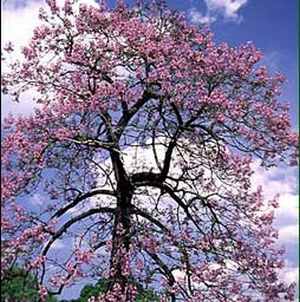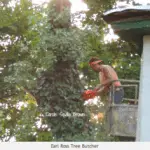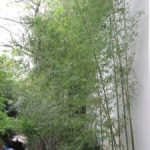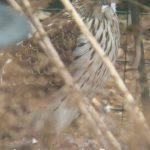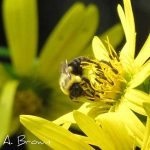Known as the Princess Tree, Empress Tree, and Royal Empress Tree, Paulownia Trees are highly invasive and are destroying native ecosystems from Maine to Florida and Texas, as well as the Pacific Northwest. However, open almost any gardening magazine and you’ll find adds touting this tree as an “amazing, fast-growing, shade tree.”
It is this fast-growing nature that is causing so many problems for native ecosystems. Growing up to 15 feet in a single year, this invasive tree shades out and outcompetes native plant communities for resources such as water and nutrients.
It thrives in disturbed soils, is drought and pollution tolerant, and easily takes over riparian areas. Every spring when it blooms, I am dismayed at how many more of these trees have gained a foothold along the wooded stream as I drive through my neighborhood.
It can reproduce from seed or root sprouts, which grow very quickly. A single tree can produce up to 20 million seeds each year, which are easily dispersed by wind and water. Even though the light purple blooms are quite pretty, I have learned to hate the sight of them.
Sale of this plant is banned in Connecticut and it needs to be banned in all of the other states in which it has spread into natural areas. Continued sale of this plant is extremely irresponsible. If your local nursery is selling this tree, please inform them of how invasive and dangerous it is to our native ecosystems.
When Good Intentions Can Have Disastrous Consequences
I came across a website recently which has a great mission. Tree Your World is planting trees to sequester carbon dioxide in the hope of slowing global climate change. They are enlisting environmentally conscious affiliate organizations, corporations, schools, churches and individuals to join in their efforts to help nature help itself while profiting from the experience.
The problem is, they are planting vast plantations of Royal Empress Paulownia trees, which they describe as the world’s fastest growing tree. These plantations are creating a vast seedbank of this highly invasive tree, which will spread through native forests, riparian areas, and disturbed areas.
While they may be acting with the best of intentions, their actions are nonetheless very irresponsible.
Leave Us Your Comments Below!
Click the Submit Your Comments button below to leave us your comments, questions, or feedback!
We thank our friends at NoDepositPromoCodes for supporting EcosystemGardening!
More From Ecosystem Gardening:
Submit your review | |
In all my years (69), I've never encountered a plant that you cannot destroy. My step father planted one of these in the front yard of our rural farmhouse next to the road. He was sold on the fact that it would grow tall fast.. it did.. it also pushed the road up requiring the county road crew to fix the road twice. Upon his death, I asked the county to cut it down to save them from having to continuously repair the road. They cut it down and I had the stump ground. That's when the trouble started for me. Out of nowhere, little trees started popping up in my lawn and as far out as 75 yards into the fields around the house. The most alarming thing was that it was growing up under the house and had sent suckers into our kitchen cabinets along the floor. It grew through cracks that a mouse could never come through, and ended up in one of our drawers.. my wife was not impressed when she tried to open the drawer to find a bunch of leaves and what looked like long straws clogging her pot hold drawer. This tree needs to be avoided at all costs. Do not listen to the naysayers as they're more than likely sellers of these dangerous plants. I have to spray these little pop-up trees every week or so as to not let them take over.
Its not native, therefore the native herbivorous insects have not evolved (takes hundreds of thousands of years) to get past its chemical defenses to eat it. If bugs aren't sustained by it, then birds dont have bug food to feed their young. The more aliens displace natives, the less bugs and birds will be around. We need them.
Ornamental plants (aliens) started to be used in gardens so us humans didnt have to see bugs ruining the foilage. made sense back then, but we are much more knowledgeable about our complicated ecosystem that we SURVIVE off of. We have developed the shit out of this world. We haven't shared enough space with our fellow animals. Now there are just scattered fragments of native ecosystems left. We could at least do our best to support the other animals that haven't gone extinct already! Why allow alien species over native? It should be illegal to sell aliens, imo. I bet eventually it will be, once the "leaders" really listen to the experts and not the industries.
I like the article and I agree.
We planted one of these trees and it began to take overt. We cut it down and removed the stump. That didn’t stop it. It is springing up everywhere in my front yard abs we now use sucker punch and another product at least once a month to try to manage the growth. I absolutely hate this tree and agree it should be banned.
It seems that you have not followed the development of Paulownia and that you are relying solely on nursing room stories?
This is extremely regrettable.
Over the past 50 years, the Chinese have carried out a scientific development of hybrid paulownia trees, which are not invasive. Their seeds simply cannot germinate outside a laboratory, as germination constantly requires a minimum of 26 degrees C for at least 4 weeks with a humidity of 90%.
There is a very big difference between what you call Princess Tree, Empress Tree and Royal Empress Tree because these are popular names for "Paulownia Tomentosa" ... ie one of the 16 original species that in certain subtropical regions may well be invasive ,
But the hybrid varieties that are not crossed with Tomentosa are certainly not invasive.
I think you should correct your text and take these caveats into account.
In relation to the world's climate, hybrid paulownia is today considered the world's best climate tree by the UN, and is thus included in the world's largest climate program GREAT GREEN WALL of AFRICA, which has just been created by the UN.
You are welcome to contact me by email for sending recognized scientific theses.
Best regards
Jesper
I disagree with your comment regarding nature. The issue is this and other invasive species are removed from its natural environment to area's where they do not have natural controls. Sometimes the species has disease that will jump spieces and devastate other species. An example is the Chinese Chestnut carried disease that destroyed the American Chestnut. The Chinese Chestnut would have never come to the American continent if humans had not brought it here.
I found this article interesting and somewhat informative. I totally disagree with it that it should be most hated because it is invasive. You state that it out competes other themes in the ecosystem. But every plant that you currently have in the ecosystem including yourself are species outcompeted the species of hominids that came before us. If you leave nature to its own resources it will handle it. I do not think in general that it’s a good idea to spend money tax pair or otherwise to try to stop nature. It’s like spitting on a campfire. As your concern about the website tree your world. Are you going to tell me you are more concerned about controlling what you feel is invasive species then you are about global warming. By all accounts this tree will grow in many different climates and soil’s and because it matures quickly could possibly really help with global warming. Many other trees like the oak take many years before they’re able to sequester much carbon.
I think it's great that you published this article. The P. tometosa is definitely invasive in many places of the world and it's important for people to look at their specific area and determine if it's a good idea to plant it. Many official sites list it as invasive:
https://www.invasivespeciesinfo.gov/terrestrial/plants/princess-tree
https://www.invasive.org/alien/pubs/midatlantic/pato.htm
https://www.invasivespeciesinfo.gov/terrestrial/plants/princess-tree
Maybe add that the elongata is not YET classified as invasive?
I have my doubts of it not being invasive in ideal enviroments where it rains a lot...and also, why plant a chinese plant when you can plant a native and help your local wildlife? For example, in the USA, when you plant an oak you are investing for the next 250 years at least...when you plant a Pawlonia you are planting for inmediate gratification. We need many many more trees to help lower CO2 in the atmosphere, but a long lived tree will do much more for our future generations of all animals, including humans.
All invasives are native somewhere. It is planting the wrong thing in the wrong place with no regard for the impact that is the problem. Raising awareness of potential invasives is good. People often just don't research or plan before they plant things. That said, this article is very emotional (which shouldn't we be emotional when we see things aren't going well?). Emotion should be back with common sense and research however. Did you ever consider why invasives do so well? It's almost always because of a preexisting weakness in the native ecosystem or because the invasive is actually a native plant returning to its prime environment from which it was destroyed hundreds of thousands of years ago. Often an invasive is a more disease resistant or faster growing version of a native plant (yeah it's fun to look this up, and that's also why so many invasives hybridize with native plants). As someone who loves and grows many forgotten native plants, I do think people should consider the potential of any plant to get out of hand in their native area. However the people most outspoken against invasives are often rather plant illiterate and do no more to help native environments than the people causing invasive plant issues in the first place. Please be kind to the author of this article, as they are trying to do a good thing. Trash talking isn't going to educate anyone. Invasives are a problem but unfortunately articles like this are further contributing to the problem by seeming to blame the plant and treat it like a criminal when it is simply trying to thrive and contribute to its environment. This particular species enriches the soil, which some people argue is a terrible thing but there are native plants that do this as well. It is cycle. Whenever you add something you change the cycle, but remember the cycle has been changing for thousands of years. Birds and animals can start invasives too. Sometimes it is good to take a breath and consider how to help native species thrive instead of just trying to kill all the potential competition.
I would rather have a flowering shade tree that is ‘invasive’ than tacky looking cedar trees we have taking over the Texas Hill Country. At least the Royal Empress provides shade and food for our pollinators
I find your article on the paulownia aka royal empress tree to be misguided and mis-informed. Please do some research on this tree by reading scientific literature then remove this misinformation that you have posted. This tree is not damaging the ecosystem. I believe that individuals like you who have limited knowledge and fail to seek knowledge are doing more damage.
I've had royal paulownias at every house I've lived in for the past thirty years. They are the most versatile hardwood tree available. They are particularly desirable if you're a nature enthusiast or a woodworker. Some reasons why I like these trees:
Fireproof! I live in a town surrounded by national forest. I feel good that my property is protected with these trees. High water content in the leaves and bark keep the trees from igniting in wildfires. They make excellent firebreaks in at risk areas.
*They reclaim more toxins from the air than almost any other living organism. *
The leaves can be used for sileage for livestock, mulch for gardens, or a very high nutrient content compost.
Many cultures use the branches for weaving projects.
You can also plant them 2 ft. apart and weave the branches together to form a natural fence that will never blow down!
For harvesting 'forests' of these trees, blunt cutting the trunk allows the tree to grow back rapidly. If you're using it for feed, or for growing wood for building projects, they are perfect.
As for the seeding you wrote about, it takes about five years for them to bloom initially, sometimes less, but generally, they are mature before blooming. I trim mine regularly so they don't bloom. If you trim them every 2-3 years, they will never bloom, so that eliminates the issue of them being invasive. Babies that pop up get run over with the lawnmower like any other volunteer plant.
As a guitar player, an added bonus of interest is that the wood is the most common used in acoustic guitar bodies. The wood is very stable once it's dry, carves nicely also.
The worst land is not the one invaded by any plant, the worst is bare land. Empty, unproductive, desertic, pampa. The opposite, like the Amazonas area, is full of life, over and under and one of the richest in soil nutrients and production.
Paulownia elongata is one of the most productive trees, an excellent shade tree, and great for the environment in the production of oxygen.
Paulownia fortunei and Paulownia elongata are NOT invasive. Perhaps you should spend 30 seconds researching the topic before you attempt to mislead your readers next time.
such a missleading information, lie and such a shame!
OK, I've been watching a couple of Princess trees growing in my yard this wicked rainy New England summer, thinking I should cut them both down, but I needed a push. Got it. FWIW, I have no idea how they got here...must've been seeds...maybe birds brought them in? The one in my front yard grew to about 8 feet this year...competing with my peach tree, the other one half that, but is growing in a pot. Maybe it was in the composted cow manure? Who knows. I've also seen many of these trees growing along the Squannacook River, east of me...so I am guessing they float along. Anyway. Bye Bye Paulinia!
Most species of paulownia are not in vasive
Yes tematosa is invasive but it’s the ONLY paulownia that’s invasive !!!!
Fortunei and elongata are not invasive!!!
You are wrong !
all the industrial hybride paulownias are not invasive.
There are 16 original spieces, and they all can be invasive, but there are over 60 hybrides which seeds are not fertile.
We have multiple impress trees. They are horrible and literally grew under a tool shed. It lifted the shed, and the concrete foundation it was built on, off the ground and at an angle great enough that the door to the shed would not stay open without a rope. Do not buy. They grow in places you don't want them and are insanely hard to kill.
In the 18th century export china from the Orient was packed in Paulownia seeds.You will notice that there are lines of these trees near the Delaware River and the Hudson,descendants of the contents of crates unpacked at the water's edge.
I’ve read the reviews below and it is true for the wild ones or the ones that were purchased from not very informed nurseries; however, there is hope for those that do want one for the benefits. There are several nurseries that sell “sterile” princess trees and will guarantee us sterilization. These tress from the informed misery was grafted and tested vs. grown from seeds. Just FYI…?
I planted one in southern ca. The trick is to make about a 4 foot circle around it, put down something like rolled roofing, fill it in with gravel. Let it grow and it is beautiful. I bought one tree and one tree is all I got
Several years ago my husband and I bought two of these trees. We were told we had to cut it back (to one center stem) a few weeks after planting. We had one in our front yard and one in our back yard. They were so small, we put tomato cages around them so the kids walking home from school didn't accidently trample them. They grew so fast! Within 2 months the cages had to go. The first year our trees were 10 feet tall and the leaves were about 2 feet across! The next year, they were 20 feet tall and the leaves were the size of a 10 in dinner plate. The following year they were pushing 40 feet tall and the leaves were the size of one's hand. Absolutely gorgeous flowers with incredible scent. Got me yard of the month from my HOA on three different occasions! Now the bad part. The limbs/wood are not very strong. We pruned the heck out of the tree in the front yard so no limbs fell onto our parked cars during a rainstorm. The tree in the back suffered so much breakage after a mild storm, that we decided to remove it. Within a month, we must have had 1000 trees popping up all over our property, the neighbors property and onto a lake easement. We would dig out hundreds of them per day, only to have hundreds more pop up the next day. We have a wrought iron fence across the back of our property. One seedling invaded our neighbor's wrought iron fence and started warping it. We felt terrible. We dug at it, used Round-up on it, set fire to it....and still it came back, repeatedly...even though our tree was gone. We didn't have an issue with the tree in our front yard until we decided to remove it. It too had very mature limbs breaking off. We arrived home one day to find the whole top of the tree laying across our driveway. It had broken off in the middle of the tree, twisted, and landed across the driveway...no strong winds or storm. We knew we had to take it down. And yes, that's when all the SUCKERS popped up again. Honestly and truly...one unplucked sucker could grow a foot tall (in a crack, in the yard, against a water hose) in three days time! Yes, they are gorgeous. Yes, they are invasive. But if I had a bunch of land outside a residential area, I would have no issue planting several of them. One could easily have a tree-lined long driveway within a year!
This species is terrible in Wisconsin. The state DNR has labled as PROHIBITED. All those tiny seeds do germinate. It then outgrows native trees and invades prairie and other ecosystems. Only if there was a sterile horticultural variety, that might allow them to be considered. Other than that, DO NOT PLANT.
Paulownias are not invasive in the UK, where I hold The National Collection of Paulownia, nor in Europe or most of the US. I have never had a single seed germinate in the wild. It needs very dry sunny and poor soil to reproduce from seed. However when established in conditions it likes it is a very fast grower, I have four varieties that in ten to fifteen years you cannot put your arms around and touch your fingers. Not only is this tree beautiful in flower but is spectacular in leaf and easy to grow. What more do you want from a tree? This website is a biased rant from someone with a fixation about this tree—take no notice.
I can not wait to plant some of these trees because the benefits far outweigh the perceived negatives. You want to talk invasive and damaging?! Lets talk about Wisteria and Rose of Sharron!!! My neighbors invasive Wisteria and Rose of Sharon grew under my fence, under my property, up through cracks in the concrete in my driveway and here is the kicker,,,,, my brother had an old pick up truck in the back end of driveway for YEARS and when it came time to move it, we could not! The Wisteria grew up through the entire chassis and anchored the truck in place!!! It took us 2 days to free the truck and 2 years of cutting and poisoning the vines just to get them under control. 17 years later I am still killing off my neighbors highly invasive Wisteria and Rose of Sharon!!
Can the Empress Tree be grown as a 6' bush and still produce those fragrant trumpet flowers that bees and hummingbirds love?
My neighbor's 50' tree has white trumpets with barely a tinge of pink and yellow.Fragrance is over 2 houses away over a thousand honey bees on it.
Only Paulownia Tomentosa is invasive ,Paulownia Fortunei ,Kawakamii ,Coreana ,Elongata ,and Fargesii are all completely harmless and non-invasive.Check your facts better next time.
This information is catagorically incorrect as the paulownia TOMENTOSA is on the invasive species list due to its growth rate BUT its seeds are incredibly hard to germinate and tissue culture is the main reproduction method among nurseries, HOWEVER the paulownia elongata and fortunei are NOT invasive AND just as prolific growers they are most definitely the answer to our global folia crisis wood shortage and mass deforestation please remember when writing articles you are influencing peoples opinion and to negatively report on once specific gene of a tree and not make it clear that all other genes don't follow the TOMENTOSA is damaging
I purchased an imported tray made of Paulownia and was amazed at its lightness. Clearly, this is due to the rapidity of its growth. It's almost like balsa wood.
We don't have any native trees in New England that grow that way, and anything that does must have quite the advantage over the natives.
Invasive trees such as Golden Raintree (sold by Arbor Day Foundation, of all groups) and Catalpa are enough for us to wrestle with-and now I learn about Paulownia.
USDA Plants doesn't have conclusive warnings about the invasive nature of the Empress or Princess tree, nor does the description on Wikipedia. Both would be the go-to source online for anyone who hasn't learned about them yet.
I noted that all of the previous comments were written prior to the publication of this article! My guess is that they were written in response to another article on this topic. It is true that there is more than one Paulownia and it is the Paulownia tomentosa that is invasive in the US. That is the topic of this article. The value and use of this tree in its natural habitat are not in question. This tree, like the Ailanthus altissima, is an invasive brought to the US with good intentions. The fact remains, they are invasive. Do not plant them, do not encourage them, remove them if possible.
After reading the article and the comments I have to say - I agree with all of you. I have a farm and have a lot of invasive plants ( California puppy’s and Scotch Broom etc.), this year I planted morning glory on my territory. Yes, I am trying to keep plants in check but if something can bloom I won’t it. I have bees, I have goats , I have sheep. I love plants that are fast growing and regenerative . If look about Emperors Tree closer you will see that wood of this tree is priceless! People always was changing ecosystems and we don’t know what is native or what is not. So in my opinion if nature created it this way learn and use it, don’t destroy it.
Hi all,
Even if the Empress Tree is not invasive, wouldn't it still be better to find the quickest growing tree, native to the area, instead of planting Empress trees everywhere? Can a tree really be planted all over the planet without losing diverstity of microogranisms, beetles, birds, mammals, etc?
Do complete research and do not publish what 'you' think. This tree only survives in direct sunlight, it will not grow with other trees because shade derives it of sunlight. That is why it grows along highways where no other trees are growing.USDA ARTICLE FROM WASHINGTON POST DR. PETER BECKJORD,USDA SCIENTIST (March 1990) cites the tree as a solution to deforestation in developing countries due to its fast growing nature. Can be used for building lumber and is valued in the Orient for its pinkish color. In 1990 the price was $12. per brd ft. Highly prized in Japan.
(source=Washington Post Magazine, Susan Tamulevich,March 25,1990)
It's amazing how much misinformation there is in this article... who ever wrote this article should not be so bias to such an amazing trees, which is medicinal and food in order countries, but clearly not in a the food old USA lying fake media...
MOST HATED OR MOST NEEDED? BEST IN C02 ABSORPTION; FOOD AND MEDICINES... hm, no wonder the USDA GATEEKEEPERS hate it, big pharma doesn't like competition.
Thank you for this information about the Pawlonia tree/Royal Empress tree! More people need to realize the invasiveness of this tree. Do not grow it! We bought a house on a small lot and the previous owner planted a Royal Empress in the tiny front yard. She loved the flowers, loved the shade, etc. and said it was her favorite tree. Our first year in the house: raking dinner plate sized leaves. The tree never flowered, outgrew it's space and the roots pushed out the nice brick landscaping wall. We had it cut down last Fall and now this year the shoots are popping up all over the place. People! If you want to plant a tree, plant a native tree indigenous to the part of the country you live in! Please! No fake news about this tree. It's real and despite it's pretty and fragrant flowers and welcome shade, beware!
For some reason this site enjoys disparaging Paulownia, and like so many things on the Internet, you are publishing misleading, incomplete information. The writer is either uninformed or has an axe to grind. There are 4 primary species of Paulownia: Tomentosa, Elongata, Fortunei and Shan Tong. Of those 4, Tomentosa is invasive and is forbidden to plant in certain parts of the US. The other 3 are fine species of Paulownia with excellent qualities. You would do yourselves and your readers a favor if you would separate the facts from fiction: Many readers are unable to distinguish between a Paulownia Princess Tree which is of the tomentasa speciees and a Paulownia Princess Tree which if of the elongata species. Please do your research and then write knowledgeably - harsh, misleading articles detract from some of the good things you have to say. The proper thing to do would be to inform your readers that a certain species of Paulownia should be avoided due to its tendency to be invasive, but it is unfair and inaccurate to lump all species in the same category.
I am in the UK. and currently grow ALL 9 different Paulownias Species to maturity. Three are listed as UK ‘Champion Trees’ with. TROBI the UK tree register online- do look it up- however I have never had or seen a single self seeded tree. We do have warm dry weather in the south and east and cooler wetter in the north west but clearly our climate does not suit self seeding whilst the trees themselves grow well and fast. They can regenerate from the roots if the tree is cut down but not excessively. So I guess it can only be a problem in just a few areas or States. All varieties are very similar there is no significant difference between the more common tomentosa and elongate or indeed the others. Only ‘Fast Blue’ is significantly quicker and a larger tree. So your ‘hatred’ of this species i consider to be somewhat misplaced. Indeed at this time in early May there are no more beautiful trees.
David
Bath UK
Paulownia Tomentosa was introduced into the USA in the mid-19th Century -- 170+ years ago. Ask yourself this question. If so terribly invasive?... Why hasn't Paulownia established itself (naturalized) almost everywhere?... like Dandelion plants? It has not. ***** Another insight relative this topic of invasive: During the last 40 years, Paulownia has been planted globally as a fast-growing timber asset. The North American Timber Industry and (importantly) its Lobbyist have worked very hard to influence and infiltrate the media and academic articles with these claims of Paulownia Invasion.
All the complaints about shallow roots can be resolved in the first 2 years of growth by watering heavy twice a week. Paulownia can have multiple tap roots.
We have a 16 year old tree near the center of a 40 acre property and no other paulownia.
Did you get this "fake news" on the internet? Show us proof that these trees are "invasive"...I've yet to see any example in the US where these trees have taken over and wiped out other tree species. This article is merely opinion, with NO supporting facts. I have a neighbor who planted trees around his coral to provide some fast shade to his handicapped riders and his horses...beautiful trees in 10 years, and not invasive at all...no massive spreading of seeds, or anything like that. Your garbage story also ignores clear benefits of such fast growing trees.
It is only the Paulownia Tormentosa that is invasive. There are many other varieties of this tree that are not invasive. Do your research.
There are two kinds of Paulownia trees:
1. Paulownia Tomentosa (the kind you "hate")
2. Paulownia Elongata (the "good" kind)
The second kind has a fuzzy leaf and is noninvasive. It filters the air we breathe better than any other plant I have read about. It does not have a deep root system and does not produce seedlings. In fact, I've read that it's sterile. I have one in my yard (I have no idea how it got there...other than a gift from a bird) which started growing two years ago and it's beautiful.
Neighbor has one tree and now I have it growing in my yard. Her yard is covered in sprouts. Nasty thing and I told her when she planted it what it would do. Grow all over the neighborhood. Her remark was "I won't be around that long" That was maybe 5 years ago and she's trying to get rid of the sprouts. Even the dropped leaves make a big mess. Any ideas anybody? I don't want to use roundup in my yard on sprouts. And believe me, once its cut down, the sprouts start. I read caustic soda (lye) will kill the sprouts but haven't tried it yet.
I have cut this tree down. But it still is growing all over my yard. Please help, I need to stop this from growing all over my yard. I have tried different things and nothing seems to stop or kill it. I really need your help. Thank you in advance. Lynda
First of all, Most if not all of the Royal Empress trees for sale are not fertile. They are a very prestigious tree which can mature very quickly. If you are looking for a mature tree for your yard in a few years, this one is perfect. The wood from the tree is very valuable, and yes, it does absorb more co2 than any other tree, so it is in fact great for the environment.
I read that they absorb CO2 at up to 10 times the rate of other trees.
Could they save us from global warming?
Looking at the comments, I see there is more than just one type of this tree, and thus, this tree is perfectly fine. Can't wait to plant one in my yard - as long as it's the non invasive variety.
Perhaps, we should plant deserts with them (and somehow muster up the clean energy needed to obtain more water) in order to sequester some of the excess CO2 created from the conversion of literally mountains of fossil fuels.
I wonder if the wood rots quickly or if it would last for long enough until humanity figures out a better way to safely sequester excess carbon CO2 from the air, such as using unlimited solar, wind and batteries to "brute force" the conversion of excess CO2 into limestone.
I have six of these beautiful trees, they have helped cool my home. I don’t have much need for my ac because of them. They produce so much organic material that I deliver they are helping to enrich my desert like soil. I don’t rake the leaves that fall on the ground in one or two days they are dry enough that if they’re stepped on they dissolve or I use a pressure nozzle to break them apart. The seed pods do get very heavy and will cause some branches to break specially with a storm but so will other trees. I have also pruned some big branches but it’s a pleasure working with this tree. A thick branch is reduced to nothing so such ease. Mature branches are not hollow but weigh as if they were. Of the millions of seeds produced by my tree I have only had one seedling. I have five trees all clones from a tree I bought. They are root clones, when the roots are disturbed you’ll soon see a new tree trying to grow up from the area that was disrupted but they are so easily destroyed. I’m glad to hear that they have shallow roots because my tree is feet away from my septic system including the drain field and I haven’t had an issue with the system whatsoever. I love my trees they do remove a lot of carbon from the atmosphere.
I ignorantly ordered these trees from a garden center, so excited for their bloom and fast growth. The wood is soft and large branches were forever coming down in windy weather. Since the two large trees were near the property line, the leaves and branches kept messing up my neighbor's pristine lawn. Last year after a monster storm, I had the two large "Empress China" trees cut down. OH MY WORD!!! It is now like a plague! Seedlings are popping up by the dozens all over the yard AND the neighbor's yard as fast as we can pull them out. it is like whack-a-mole!!! Horrible. I don't know how to get rid of them! Help!!!

